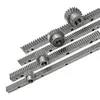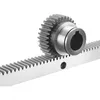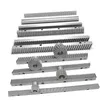A gear rack is a linear bar with teeth cut into one surface, designed to mesh with a rotating pinion gear to convert rotational motion into linear motion or vice versa. This mechanical component is essential in various industries, including automotive, robotics, manufacturing, and aerospace, due to its efficiency, precision, and durability. In this guide, we provide an in-depth look at our high-quality gear racks, detailing their specifications, applications, and answers to common questions.
Our gear racks are manufactured using premium materials and advanced processes to ensure optimal performance and longevity. Below are the detailed parameters.
| Parameter | Specification Range | Units |
|---|---|---|
| Module (Pitch) | 1 to 10 | mm |
| Length | 500 to 3000 | mm |
| Width | 20 to 100 | mm |
| Height | 15 to 80 | mm |
| Tooth Profile | Straight or helical | - |
| Accuracy Grade | DIN 5 to DIN 10 | - |
| Load Capacity | Up to 5000 | N |
| Operating Temperature | -40 to 120 | °C |
Gear racks are versatile components used in numerous systems:
What is a gear rack used for?
A gear rack is used to convert rotational motion from a pinion gear into linear motion, or vice versa, in applications such as steering systems, machinery, and robotics for precise movement control.
How do I choose the right gear rack for my application?
Consider factors like load capacity, operating environment, material compatibility, accuracy requirements, and space constraints. For high-load scenarios, alloy steel with heat treatment is recommended, while corrosive environments may benefit from stainless steel or coated options.
What is the difference between straight and helical gear racks?
Straight gear racks have teeth cut parallel to the axis, offering simplicity and cost-effectiveness. Helical gear racks have angled teeth, providing smoother engagement, reduced noise, and higher load capacity but at a higher cost.
How do I maintain a gear rack system?
Regular maintenance includes lubrication to reduce friction and wear, inspection for tooth damage or misalignment, and cleaning to prevent debris accumulation. Follow manufacturer guidelines for specific intervals and lubricants.
Can gear racks be customized?
Yes, we offer customization in terms of length, material, tooth profile, and surface treatments to meet unique application needs, ensuring optimal performance and integration.
What are common issues with gear racks and how to troubleshoot them?
Common issues include wear, backlash, and misalignment. Wear can be mitigated with proper lubrication; backlash may require adjustment or replacement of components; misalignment often needs realignment of the rack and pinion setup during installation.
Are gear racks compatible with all pinion gears?
Gear racks must match the module, pressure angle, and tooth profile of the pinion gear for proper meshing. Ensure compatibility by verifying specifications such as module size (e.g., Module 2 rack with Module 2 pinion) to avoid performance issues.




